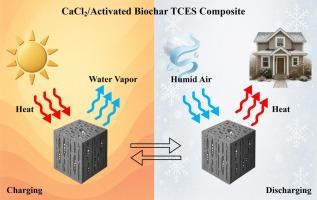基于盐和木材衍生的活性生物炭的高能量密度长期热化学储能复合材料
IF 10.9
1区 工程技术
Q1 ENERGY & FUELS
引用次数: 0
摘要
吸湿盐作为热化学储能材料,以其可观的储能密度和长期存储能力脱颖而出,但吸附过程中的团聚、潮解和传质等问题阻碍了其实际应用。为了解决这些问题,通过浸渍法开发了一种受自然启发、可持续、廉价的复合材料,该复合材料由木材衍生的多孔活性生物炭基质和CaCl2作为活性成分组成。本文研究了基体粒度对复合材料储能密度和循环稳定性的影响。此外,本研究还对盐泄漏进行了分析,并用精确的定量方法评价了复合材料的稳定性。同时使用热分析仪和加湿器对储能密度进行分析。利用扫描电子显微镜和x射线显微计算机断层扫描技术分析了盐沉积在基体表面和内部多孔结构上的变化。通过分析氮吸附/脱附等温线,表征了基体和复合材料的比表面积和孔隙率。活化的生物炭基质来源于木材的细胞和维管通道,具有多尺度多孔结构,不仅具有特殊的表面积,而且有利于传质和成功的盐浸渍。粒径在354 ~ 595µm之间的复合材料具有最佳性能,其初始储能密度约为2480 J/g。在连续10次水化/脱水和5次泄漏试验后,该复合材料的储能密度分别稳定在2310 J/g和1780 J/g。本文章由计算机程序翻译,如有差异,请以英文原文为准。

High energy density long-term thermochemical energy storage composite based on salt and wood-derived activated biochar
Hygroscopic salts as thermochemical energy storage materials stand out for their substantial energy storage density and long-term storage capability, but challenges like agglomeration, deliquescence, and mass transfer issues during sorption hinder their practical application. To resolve these problems, a nature-inspired, sustainable, and inexpensive composite composed of a wood-derived porous activated biochar matrix and CaCl2 as active component is developed through an impregnation method. This study investigates how matrix particle size affects the energy storage density and cyclic stability of the composite. In addition, this research analyzes the salt leakage and evaluates the stability of the composite by using an accurate quantitative method. A simultaneous thermal analyzer coupled with a humidifier was used to analyze the energy storage density. Scanning electron microscopy and X-ray micro-computed tomography were used to analyze salt deposition on the outer surface and inner porous structure of the matrices. The surface area and porosity of the matrix and composite samples were characterized by analyzing nitrogen adsorption/desorption isotherms. Derived from cellular and vascular channels of wood, the activated biochar matrix shows a multi-scale porous structure that not only has exceptional surface area but also facilitates mass transfer as well as successful salt impregnation. A particle diameter between 354 to 595 µm leads to synthesis of the composite with optimal performance, exhibiting an initial energy storage density of approximately 2480 J/g. The energy storage density of this composite remains stable at 2310 J/g and 1780 J/g after 10 consecutive hydration/dehydration and 5 leakage test cycles respectively.
求助全文
通过发布文献求助,成功后即可免费获取论文全文。
去求助
来源期刊

Energy Conversion and Management
工程技术-力学
CiteScore
19.00
自引率
11.50%
发文量
1304
审稿时长
17 days
期刊介绍:
The journal Energy Conversion and Management provides a forum for publishing original contributions and comprehensive technical review articles of interdisciplinary and original research on all important energy topics.
The topics considered include energy generation, utilization, conversion, storage, transmission, conservation, management and sustainability. These topics typically involve various types of energy such as mechanical, thermal, nuclear, chemical, electromagnetic, magnetic and electric. These energy types cover all known energy resources, including renewable resources (e.g., solar, bio, hydro, wind, geothermal and ocean energy), fossil fuels and nuclear resources.
 求助内容:
求助内容: 应助结果提醒方式:
应助结果提醒方式:


